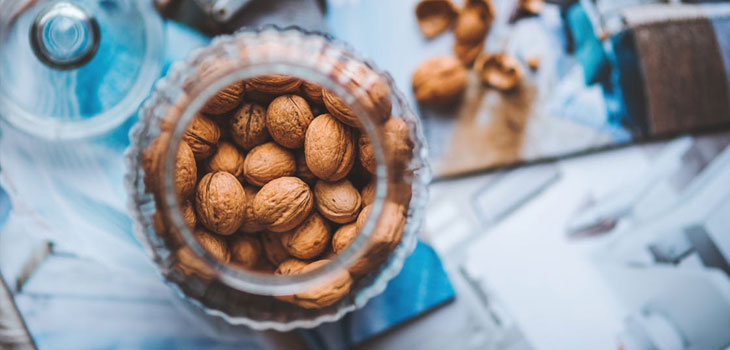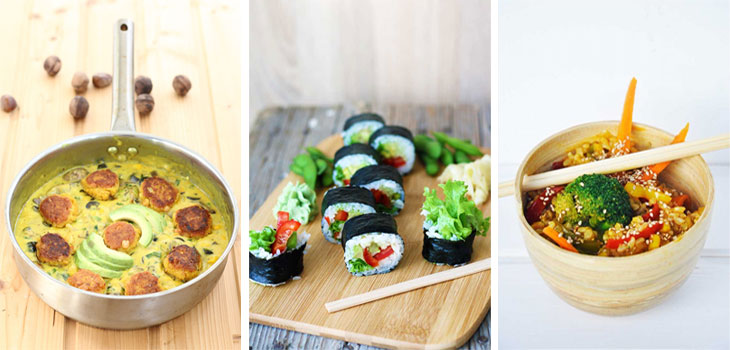Food Allergies – Everything You Need To Know About Them
Did you know that food allergies affect around 5% of adults and 8% of children? The scarier fact is that the numbers are rising at an alarming rate every year. Interestingly, although it is possible for any food to cause an allergy, most food allergies are caused by just eight foods, which we will discuss in detail.
Feel free to leave me a comment if you have any questions. I will answer you right away! Also, if you want a customized meal plan, fit for your special dietary needs, here’s the meal planner app I created. It generates personalized recipes I carefully crated so you can enjoy a healthy, delicious diet without worrying about what you’re going to eat ever again! 🙂
Contents:
- What are food allergies?
- What are the symptoms of a food allergy?
- What are the different types of food allergies?
- Food allergy risk factors
- How can you avoid food allergies?
- Foods that cause allergies
- Cow’s Milk Allergy
- Eggs Allergy
- Peanuts Allergy
- Tree Nuts Allergy
- Shellfish Allergy
- Fish Allergy
- Wheat Allergy
- Soy Allergy
- Do other foods cause allergies too?
- Do you have any food allergies?
IMPORTANT! Food allergies are different from food intolerances. I discussed the food intolerance subject in more detail in a previous post.
What are food allergies?
A food allergy is a condition in which certain foods trigger an abnormal immune response. It is caused by your immune system wrongly recognizing some of the proteins in a food as harmful. The body reacts by launching a range of protective measures, such as the release of chemicals like histamine, which causes inflammation.
What are the symptoms of a food allergy?
For people who have a food allergy, even exposure to very small amounts of the problem food can cause an allergic reaction. Symptoms can appear anywhere from a few minutes after the exposure to the allergen to a few hours later, and they may include some of the following symptoms:
- Swelling of the tongue, mouth or face
- Difficulty breathing
- Low blood pressure
- Vomiting
- Diarrhea
- Hives
- Itchy rash
In more severe cases, a food allergy can cause anaphylaxis. Among the most frequent and quick symptoms is the appearance of an itchy rash, the swelling of the throat or tongue, shortness of breath and even low blood pressure.
What are the different types of food allergies?
- Immunoglobulin E (IgE) mediated – Symptoms result from the body’s immune system making antibodies called Immunoglobulin E (IgE) antibodies. These IgE antibodies react with a certain food.
- Non-IgE mediated – Other parts of the body’s immune system react to a certain food. It causes some symptoms but it does not involve an IgE antibody. A person can have both IgE mediated and non-IgE mediated food allergies.
Food allergy risk factors
- Family history – If asthma, eczema, hives or hay fever are common health issues in your family, you are prone to developing an allergy.
- Other allergies – If you’re already allergic to one food, you may be at increased risk of becoming allergic to another. Also, your risk of having a food allergy is greater if you have other types of allergic reactions (hay fever or eczema, for example).
- Age – Food allergies are more common in children, especially toddlers and infants. With age, your digestive system matures and your body is less likely to trigger allergies. Fortunately, children typically outgrow allergies to milk, soy, wheat and eggs. Severe allergies and allergies to nuts and shellfish are more likely to be lifelong.
- Asthma – Asthma and food allergy commonly occur together. When they do, both food allergy and asthma symptoms are more likely to be severe.
How can you avoid food allergies?
The answer is simple – stay away from those foods that trigger vicious symptoms in your body. Once the food, which is allergic to the patient, is recognized, the safest way to avoid allergy is to remove the food from your diet.
To make this practical is a bit difficult you have to read out all the ingredients in detail on the label of each food. Many foodstuffs can have the allergy-causing food materials such as eggs, peanuts, and milk, although these may not be directly associated with the food.
For example, milk is found in many bakery products, peanuts are associated with protein supplements, and some of the salad dressings contain a good proportion of eggs. You should avoid foods that the body is sensitive to, and even in restaurants, please order those things that you know are safe.
If you have any of these food allergies or intolerances and you have problems figuring out what to eat, I created the meal planner app to help you! Thousands of people with food allergies and intolerances have already used it. Check out the details, here.
Foods that cause allergies
Cow’s Milk Allergy
Babies and children are the ones who usually have an allergy to cow’s milk. This is usually triggered because of the exposure to cow’s milk protein before they age of six months old. However, around 90% of children will outgrow the condition by the time they are three, making it much less common in adults.
It can occur in both IgE and non-IgE forms, but the former is the most common and serious. People with an IgE allergy usually have a reaction within 5–30 minutes of ingesting cow’s milk. They experience symptoms like swelling, rashes, hives, vomiting and, in rare cases, anaphylaxis.

Eggs Allergy
Symptoms of egg allergies include digestive distress, such as a stomach ache, skin reactions, such as hives or a rash, respiratory problems, or anaphylaxis (which is rare). It is often possible to be allergic to egg whites, but not the yolks, and vice versa. This is because the proteins in egg whites and egg yolks differ slightly.
Yet most of the proteins that trigger an allergy are found in egg whites, so an egg white allergy is more common. Just like in the case of other allergies, the treatment for an egg allergy is eliminating eggs from your diet. However, you may not have to avoid all egg-related foods, as heating eggs can change the shape of the allergy-causing proteins.
Cooking eggs tricks your body from seeing them as harmful, meaning they’re an allergic reaction is less likely. Nevertheless, this isn’t the case for everybody, and the consequences of ingesting eggs when you are allergic to them can be severe. Because of this, you should check with your doctor before you reintroduce any egg-containing foods.

Peanuts Allergy
Like a tree nut allergy, peanut allergies are very common and can cause severe and potentially fatal allergic reactions. Even though peanut is a legume, not a nut, those with peanut allergies are often also allergic to tree nuts. While the reason people develop a peanut allergy isn’t known, it is thought that people with a family history of peanut allergies are most at risk.
It was previously thought that introducing peanuts through a breastfeeding mother’s diet or during weaning may trigger a peanut allergy. This is not the case, as studies have shown that this can actually be protective. Treatment is lifelong avoidance of peanuts and peanut-containing products.

Tree Nuts Allergy
Examples of tree nuts are Brazil nuts, almonds, cashews, macadamia nuts, pistachios, pine nuts, and walnuts. People with a tree nut allergy are also allergic to food products made with these nuts, such as nut butters and oils. If you have a tree nuts allergy it is best you avoid all types of tree nuts, even if you’re allergic to only one or two types. This is due to the fact that it increases your risk of developing an allergy to other types of tree nuts.
In this case, it is easier to avoid all nuts, rather than just one or two types. An allergy to tree nuts is usually a lifelong condition. They can also be very severe, and tree nut allergies are responsible for around 50% of anaphylaxis-related deaths.

Shellfish Allergy
Shellfish allergies are caused by your body attacking the proteins from the crustacean and mollusk families of fish. Examples of shellfish include shrimp, prawns, squid, scallops, lobster, crayfish, etc.
The most common trigger of a seafood allergy is a protein called tropomyosin, but other proteins such as arginine kinase and myosin light chain can trigger an immune response too.
Symptoms of a shellfish allergy are similar to other IgE food allergies and can be quite serious. Unfortunately, a true seafood allergy can sometimes be hard to differentiate from an adverse reaction to a contaminant of seafood. The symptoms can be similar, as both can cause digestive issues like vomiting, diarrhea and stomach pain.
A shellfish allergy doesn’t pass with time, so for most people with the condition, the complete exclusion of shellfish from their diet is mandatory in order to avoid having an allergic reaction. Interestingly, even the vapors from cooking shellfish can trigger an allergy. This means that many people are also advised to avoid being around seafood when it’s being cooked.

Fish Allergy
Unlike other allergies, it is not uncommon for a fish allergy to surface later in life, with 40% of people developing the allergy as an adult. Like a shellfish allergy, a fish allergy can cause a serious and potentially fatal allergic reaction. The main symptoms are vomiting and diarrhea, but anaphylaxis can also occur in rare cases. This means that those who are allergic to fish are usually given an epi-pen to carry in case they accidentally eat fish.
Because the symptoms can be similar, a fish allergy is sometimes confused for a reaction to a contaminant in fish, such as bacteria, viruses or toxins. Many people with a fish allergy are allergic to one or more types of fish.

Wheat Allergy
Like other allergies, a wheat allergy can result in digestive distress, hives, vomiting, rashes, swelling and, in severe cases, anaphylaxis. It is often confused with celiac disease and non-celiac gluten sensitivity, which can have similar digestive symptoms. However, a true wheat allergy causes an immune response to one of the hundreds of proteins found in wheat. This reaction can be severe and sometimes fatal.
On the other hand, celiac disease and non-celiac gluten sensitivity are not life-threatening. They are caused by an abnormal immune reaction to gluten that also happens to be found in wheat. People with celiac disease or non-celiac gluten sensitivity have to avoid wheat and other grains that contain the protein gluten. But those with a wheat allergy only need to avoid wheat and can tolerate gluten from grains that don’t contain wheat.

Soy Allergy
Soy allergies are triggered by a protein in soybeans or soybean-containing products. The symptoms are: itchy, tingly mouth and runny nose, rashes, asthma or breathing difficulties. In rare cases, a soy allergy can also cause anaphylaxis.
A small number of babies who are allergic to cow’s milk can also be allergic to soy. Soybeans and soy products like soy milk or soy sauce are the common triggers of this allergy. Always read the food labels, since soy is found in many foods.

If you have any of these food allergies and you have problems figuring out what to eat, I created the meal planner app to help you! Thousands of people with food allergies have already used it. Check out the details, here.
Do other foods cause allergies too?
Less common food allergies can cause an array of symptoms, ranging from mild itching of the lips and mouth (known as oral allergy syndrome) to life-threatening anaphylaxis.
Some less common food allergies include:
- Linseed
- Sesame seed
- Peach
- Banana
- Avocado
- Kiwifruit
- Passionfruit
- Celery
- Garlic
- Mustard seeds
- Aniseed
- Chamomile
Do you have any food allergies?
Do you develop an unexplainable itchy rash after eating shellfish or certain varieties of fish? How about after eating eggs or after gulping down a warm glass of milk? Have you ever experienced that unusual tingling in your mouth after eating a particular food? These are signs of food allergies but you need to be 100% sure before proceeding to find ways to treat it.
To ascertain whether you have an allergy or an intolerance, your doctor will probably carry out a number of diagnostic tests such as:
- Dietary review – A detailed review of foods eaten, including timing and symptoms.
- Skin prick testing – A small amount of food is “pricked” into the skin using a tiny needle. The skin is then monitored for a reaction.
- Oral food challenges – The problem food is eaten in a controlled environment under medical supervision in gradually increasing amounts.
- Blood tests – In some circumstances, blood will be drawn and the level of IgE antibodies measured.
There is no need to panic if you have a food allergy – it isn’t the end of the world. All it means is that you have to structure your food habits properly in order to live a healthy lifestyle. At times, it might involve giving up your favorite food item or snack – it is difficult, but your health is the top priority. Consulting a professional is advisable as they can guide you through the process, and over time it becomes bearable.
Photo Sources:
- https://pixabay.com/en/salad-fruits-fruit-berries-nuts-2756467/
- https://www.pexels.com/photo/caffeine-coffee-cup-drink-374780/
- https://www.pexels.com/photo/appetizer-avocado-bread-breakfast-566566/
- https://www.pexels.com/photo/brown-peanuts-209345/
- https://www.pexels.com/photo/walnuts-in-the-jar-5949/
- https://www.pexels.com/photo/appetizer-crab-cuisine-delicious-566345/
- https://pixabay.com/en/abstract-angel-bass-beach-butter-1238248/
- https://www.pexels.com/photo/sliced-bread-beside-wheat-on-table-209403/
- https://pixabay.com/en/soy-milk-soy-soybean-soy-milk-2263942/






